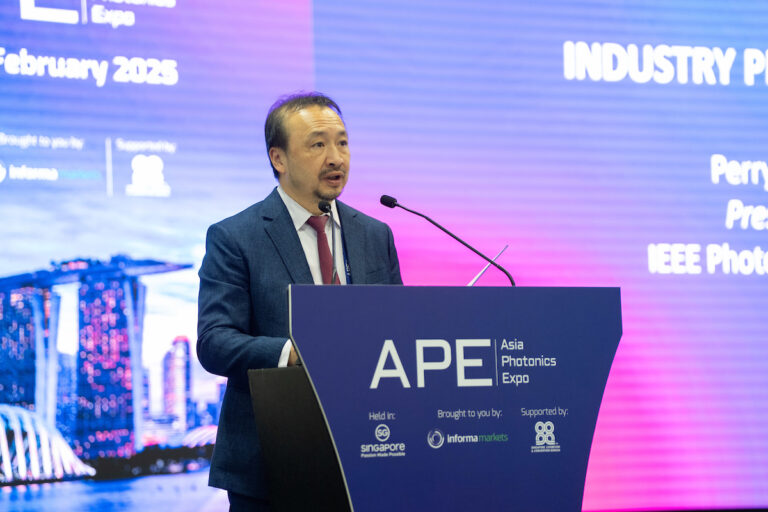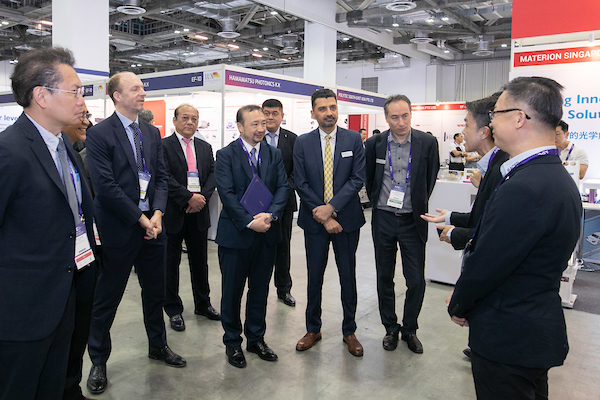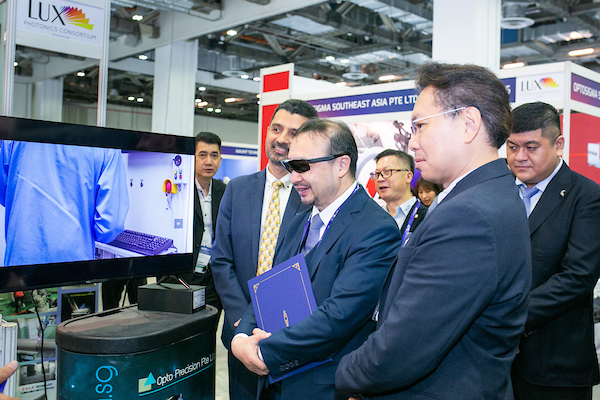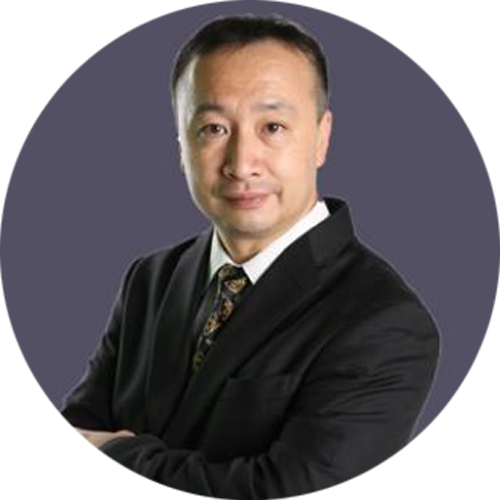Photonics Spotlight is a content-driven initiative by Asia Photonics Expo (APE) that features respected voices in the photonics industry through short video or written interviews. The goal is to showcase thought leadership, expert insights, and emerging trends that are shaping the future of the industry.
Optical fiber technology has fundamentally transformed how we observe, perceive, communicate, and live. Particularly in telecommunications and other industries, its development and applications have advanced at a remarkable pace.
Against this backdrop, we had the privilege of speaking with Professor Perry Ping Shum, a pioneer in optical fiber technology and its industrial applications, who shared insights into the opportunities this technology has created for various industries.

Professor Perry Ping Shum at the Opening Ceremony of APE 2025
Q: Reflecting on the significant advancement of optical fiber technology in recent decades, and your pioneering contributions in specialty fibers, sensors, and lasers, which three industries do you believe have been, or will be, most transformed by this technology?
A: The top three industries are laser manufacturing, sensing, and broadband communications. Current trends suggest data transmission capacity could increase tenfold within the next decade. Fiber technology’s reliability and speed will drive continued investment across industries. Secure, high-speed data transmission remains a critical global need, indicating a very promising future for the fiber optics sector.
Q: Optical fiber communication has revolutionized telecommunications. What are the current main challenges and trends? When might we reach the physical limits of fiber capacity and transmission distance?
A: Optical fibers form the information superhighway, yet current communication primarily utilizes the C and L bands (1525nm-1625nm). Since Dr. Kao’s 1966 proposal, fiber loss has decreased dramatically, from 1000 dB/km to below 0.2 dB/km. Key innovations include the erbium-doped fiber amplifier (1987) and the photonic crystal fiber (1997), enabling complex device development.
The primary challenge and trend involve developing new fiber types to enhance speed and data rates. Coreless fibers are one approach, though hollow-core fibers face surface mode loss issues. Anti-resonant fibers show significant potential, with losses lower than silica fiber theoretical limit. Humanity is far from reaching fundamental capacity or distance limits. For perspective, the naked eye can perceive stars like V762 Cassiopeiae, located approximately 16,308 light-years away.
Q: Distributed Acoustic Sensing (DAS) has seen rapid development. What is its significance and key application areas?
A: DAS enables rapid, long-range, distributed measurements based on phase-sensitive optical time-domain reflectometry (ϕ-OTDR). Applications include geological sensing, oil & gas safety, intrusion detection, and railway monitoring. Recent R&D focuses on enhancing ϕ-OTDR performance: reducing noise, improving dynamics, enabling multi-disturbance sampling, and increasing spatial resolution. DAS holds strong promise for security, confidentiality, and integrity monitoring systems.


Professor Perry Ping Shum at the exhibition tour of APE 2024
Q: Fiber lasers dominate laser manufacturing. What are their key development trends for the next decade? Is there a competing technology potentially surpassing them in continuous power or high-performance ultrashort pulses?
A: Fiber lasers offer high power, reliability, compactness, low noise, and excellent beam quality, making them essential for welding, cutting, marking, printing, micromachining, drilling, soldering, and annealing. Future trends demand higher-power continuous-wave lasers and pulsed lasers with higher average power and shorter pulses (femtosecond/picosecond) for precise thermal ablation. Developing low-cost short-pulse lasers requires research into high-power optical amplifiers and efficient wavelength-specific power combiners. Thin-disk lasers represent a potential competitor, particularly in high pulse energy and high average power applications.
Q: Fiber-optic endoscopes are widely researched. What are their advantages and disadvantages compared to other in-situ sensing technologies?
A: Endoscopes serve industrial and medical fields. Medically, fiber-optic endoscopes offer flexibility over rigid scopes, accessing non-rectal cavities and hollow organs. Compared to non-fiber alternatives like capsule endoscopes, fiber-optic versions are more compact, deliver higher optical power, and allow distal photodetector connection – significantly more powerful than proximal detectors. Integrated fibers also enable therapeutic high-power laser procedures (e.g., ablation). Weaknesses are minor and application-dependent; they are unsuitable for wireless scenarios.
Q: What are the key development trends for fiber optics? Which emerging technologies or directions deserve particular attention?
A: Strong demand and advanced research drive fiber optics. Anti-resonant fibers are a particularly significant emerging type. Light speed within fibers is reduced by the material’s refractive index. Anti-resonant fiber cores approximate air, potentially offering lower loss and meeting future speed/latency requirements. However, significant technological barriers remain to be overcome.
Q: As IEEE Photonics Society President, what are your key plans and goals?
A: Key initiatives include fostering student chapter establishment globally to build connections for the next generation of photonics professionals. Promoting member growth and collaboration through these chapters is vital. I look forward to engaging with members at conferences to understand their needs and goals, guiding the Society towards a brighter future.
Q: What are your thoughts on Asia Photonics Expo 2026?
A: The Asia Photonics Expo extends beyond showcasing cutting-edge research; it is a vibrant platform for collaboration, learning, and inspiration. It facilitates idea exchange, partnership development, and shapes photonics’ future. I encourage active participation – engage with peers, share your expertise, and embrace this opportunity.
Professor Perry Ping Shum’s Biography

Professor Perry Ping Shum is a chair professor of the Department of Electronics and Electrical Engineering, chief scientist of the State Key Laboratory of Optical Fiber and Cable Manufacture Technology, director of Guangdong Key Laboratory of Integrated Optoelectronics Intellisense, Southern University of Science and Technology. He is a National Distinguished Expert, COS Fellow, IEEE Fellow, SPIE Fellow, OPTICA Fellow, and President of the IEEE Photonics Society. He has published 400 journal papers with about 20 thousand citations and an H-index of 70 in fiber-based technology, laser, silicon photonics, medical imaging and endoscopy, intelligent medical diagnosis techniques, and computational imaging. As the person in charge, he has been granted more than 60 million research funds in recent years. He served as director of the Network Technology Research Centre (NTRC), Photonics Centre of Excellence (OPTIMUS), and Centre for Optical Fibre Technology (COFT), and deputy dean in charge of academic programs at Nanyang Technological University, Singapore. During this period, a world-class fiber research / processing center was created, enabling Singapore to manufacture special fiber optics, special fiber lasers, and sensors. He chaired several major international conferences, including CLEO-PR | OECC| PGC 2017, and initiated several international conferences, such as PGC, ICOCN, ICAIT, OGC, etc. He collaborates closely with universities and institutes worldwide.

.png)




